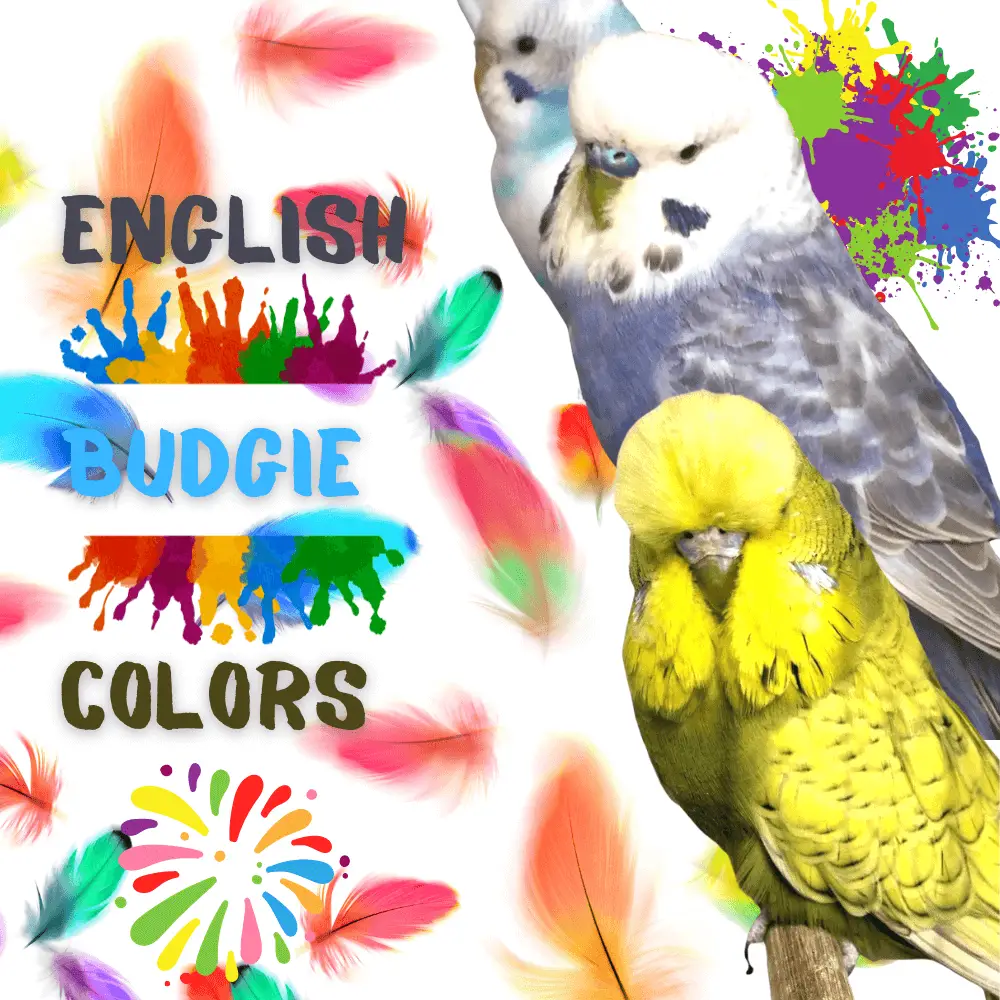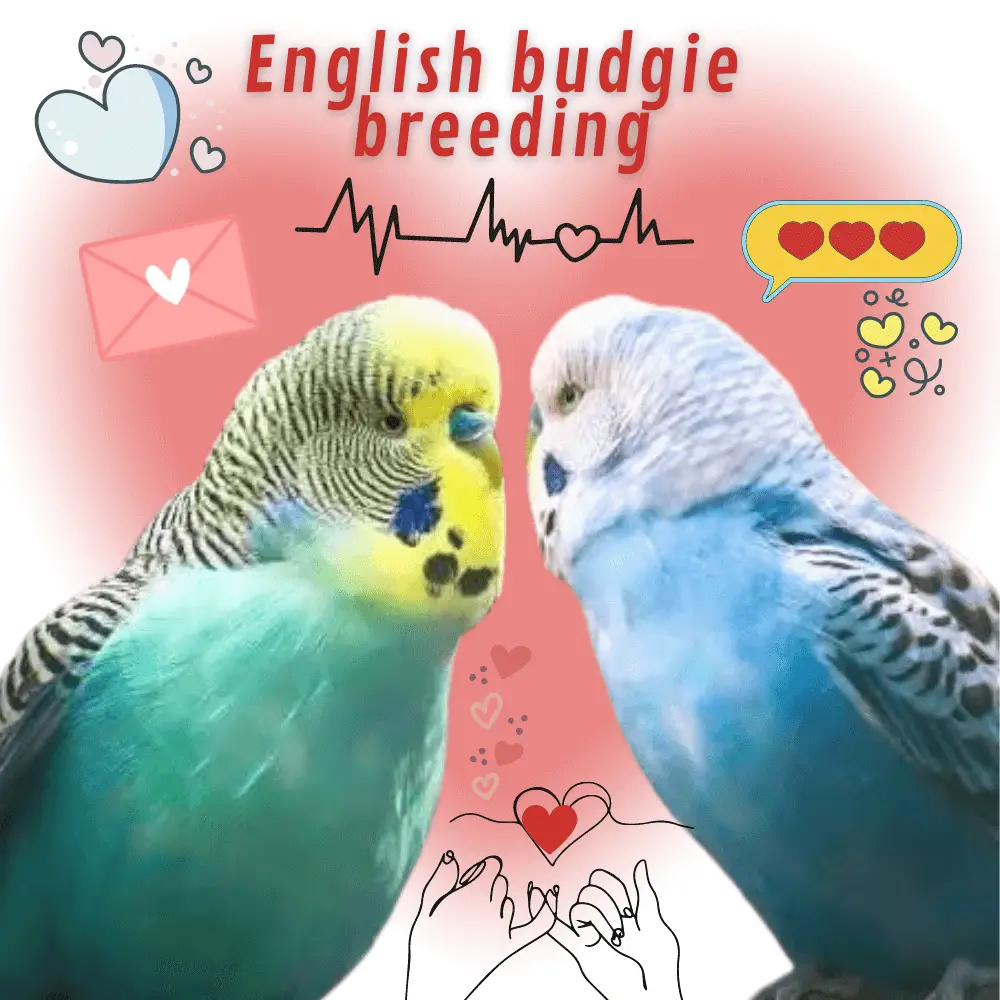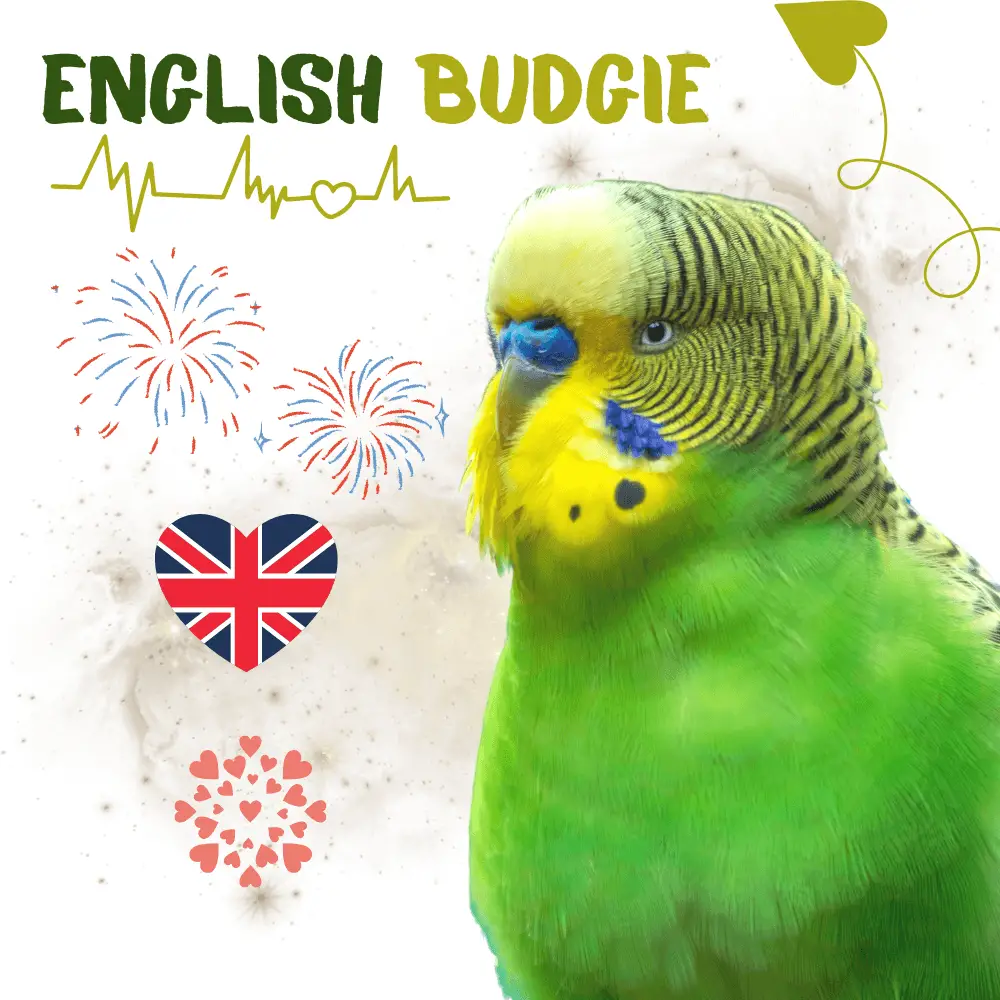English budgie: If you want to have a bird at home, the best option is to bet on a budgie. And it really is the right thing to do, especially when you don’t have much experience caring for a parrot.
How did this species emerge?
As everyone knows, the Australian budgie is the one which is known as the common parakeet, but after a long period of work, a new species has been created which has been baptized as the English budgie (or posture budgerigar ). , because he was brought up in England.
We could say that we are dealing with a rather new species, given that the English budgie took more than half a century to become what it is today, after the great efforts of breeders in selective breeding. The English budgie was born in 1989.
English budgie Personality
The English budgie is generally a calm and relaxed pet. She was trained for pet shows and shows where a restless bird will be disqualified.
So if you’re looking for a quiet, quieter bird in your quest, the English budgie is exactly your type. In addition, they adapt very well to a family with children or to a first time.
In addition, they are more likely to swing, jump and play while bouncing than to fly.
I once saw an English budgie rolling a hamster wheel trying to reach the corn above. Although the size of the bird was a key factor, otherwise she wouldn’t have been able to push him at all.
One unique thing that I love about their personality is that they can learn to speak a lot of words if taught to them. In fact, an English budgie holds the record for the most words learned by a bird at over 1,700 words.
Most of the time, people don’t even notice this quality because of their deep voice. Also, these birds do well when kept alone or in groups.
English budgie colors

The English budgie has a yellow neck and throat. The throat has a series of black spots, all of the same size, and on each side of the neck some dark blue drops terminating in two small black spots. Its beak is light-colored except in the area where it joins the face, which has flesh without blue feathers.
Their chest, abdomen, and lower part of their tail are light green, reaching down to their short legs which are light blue. However, its back and wings never, ever mix yellow and black in feathers that look wavy. It stands out above all for its large size when perched on the hangers.
Among the species of English parakeets there are smaller specimens, around 10 cm, and others that can reach 15 cm, and instead of having smooth plumage, they can have With a lot of feathers or a small crest on the head. In these cases, it is considered a “pseudo” English budgie.
English budgie size
You should already know that the English budgie is larger than most wild parakeets, native to Australia and even Florida.
The most pronounced part is their weight. An English parakeet weighs on average between 45.3 and 65.3 g. That’s probably why they’re more swingers than fliers.
Additionally, they can grow to a remarkable 10 inches in length from the head to the tip of the tail. It’s a noticeable difference, but not as drastic as when you compare a cockatoo to a cockatiel.
Perhaps in the context of their use in exhibition, they also present a unique appearance.
In the photo below, the bird on the far left is an English parakeet.
Most noticeable is the larger size of their head. Some are covered in head feathers that seem to blind their sight. But, they can still see.
Their color variation is also very vivid. She transcends the usual mix of a green body, yellow head, and black tail feathers in wild parakeets. Some breeds have a variety of rare colors, such as olive, gray, cinnamon, and purple.
The color patterns on English parakeets are no different. These intricate designs ranging from opaline to foot to golden face are the result of years of study and reproduction.
These birds are not regulars in pet stores, which usually sell American parakeets.
English budgie care
Hygiene becomes a necessity in the English budgie because, being birds with large plumage, if we do not do it once a week we can have serious problems with feathers and parasites, so it is essential to clean the cage, sticks, drinkers, and feeders.
As far as the bird is concerned, it is important to trim the feathers around the back to avoid the accumulation of droppings which could lead to infections in this area.
To avoid worrying about external parasites, we apply a drop of “Ivermectin ” to the neck every six months. This product is harmless to our birds and we can use it with peace of mind.
When they are just over three months old and begin their first molt (“juvenile molt”) they start to shed some feathers and this is a good time to start very gently with the baths.
The bath is done with a spray, adding a few drops of glycerin to the water to give luster to the feathers; with this, we can intensify and wet the parts that we see that need it most.
This can be done occasionally, as we see fit, and mid-morning to give the birds time to dry off quickly, never at night or in the evening. Never put a bathtub in the cage, as it can cause infections by drinking the water they bathe in.
Molting is an absolutely normal and inevitable phenomenon in birds. Feathers are formations of the most superficial part of the skin (epidermis) which, after developing in the follicle, are nourished by imbibition. In other words, they feed not on the basis of direct irrigation of a blood vessel, but on the basis of fluids from nearby blood vessels.
As the feather ages, the connective tissue around the feather follicle also ages and gradually blocks these blood vessels, resulting in the feather dying and falling off.
This change of plumage, which can be more or less complete, increases the nutritional needs of the bird (especially during the process of feathering the young) in sulfur amino acids and certain vitamins, in order to ensure good growth of the new plumage. , as well as a calm, warm, and relatively dark environment.
The truth is that it is not very different from other parakeets. Since it is not very large, you will only need a suitable cage in which you can stretch your wings from time to time to fly from side to side. The character is generally not very aggressive and does not mind sharing the cage with members of another species.
Since it does not have sexual dimorphism, its breeding is not highly recommended for people who lack experience in this area. Breeding them is not much different from obtaining a common Australian parakeet, but obtaining a pure English parakeet is quite complicated even for more experienced breeders.
What food do budgies eat
Their diet is mainly made up of canary seeds, but they can also be given other foods such as pieces of fruit, vegetables, or seeds, as long as they are not sprouted, so that they receive nutrients. So that your plumage is always shiny, it is good to give it a vitamin complex in the water.
It is not a bird intended for training, nor considered a domestic bird, but rather a species that was created for exhibition competitions. However, some breeders often teach you a few tricks such as how to finger climb or eat off your hand. Not as intelligent as other bird species, but with a little patience these little tricks can be taught to you without too much difficulty.
English budgie breeding
The parakeet is evolutionarily designed to be early in its reproduction since this is not determined by the seasons as in the case of other types of birds but is subject to good conditions, in which great importance is given to the nest, an abundance of water and seeds, the effect of “hours of light”, and mild temperatures, which cause the onset of various ceremonies and rituals whose main object is sexual attraction, stimulation and excite the individual of the opposite sex with whom he is going to form a couple, thus achieving harmonious affective behavior in the couple, the tray.
As for the light points that we have in our aviary, we must take into account that birds are much more sensitive to light than humans and that the intensities we see are low, for birds the perception is much higher. In this sense,
we must focus our efforts on obtaining good quality light, especially in terms of spectrum, and not so much on the power of the light. Full-spectrum light, similar to sunlight, which provides ultraviolet rays, has important organic and metabolic benefits for our birds.
It should be clarified that having reproductive capacity is not the same as being in a reproductive state. These birds are not fully formed by 5 months, but they already have the ability to reproduce.
What is the age to start breeding?
I think the answer must first consider whether the bird is in reproductive condition and then whether its physical and emotional development is adequate.
With a good diet, good condition (strong and developed), and after completely overcoming the second molt (7 months), from 8 months you can already consider breeding. It must be taken into account that the breeding season requires more effort from the female than the male, and in my experience, I have seen females at the age of five and a half months begin to lay their eggs, and their physical development automatically stops, leaving them with a very deficient size. This is why it is best to wait a full year (mainly in females) for the birds to develop their full physical potential before demanding their full dedication to rearing the offspring.
There are several factors to take into account before proceeding with the matings, such as the time that we have associated with the number of pairs to control each of them; another factor is space since overcrowding will only bring problems and finally, we must be consistent in estimating the dedication our aviary will need to stay in excellent hygienic conditions.
A characteristic that will help us is that these animals from Australia, perhaps due to their need to survive in an extremely selective environment, maintain the spasmodic need to have a partner by their side in perfect shape, which will facilitate training. of couples. In case things don’t go well the first time, patience and swapping males is usually the solution until we find a compatible couple.
There are breeders who only seek champions for breeding, however, on this issue my opinion is that for a champion to be at the same time a good breeder, the sample must come from a strain genetically stabilized and selected for years by correctly applying close, medium and large inbreeding (inbreeding and linebreeding).
If, on the contrary, the specimen is of exogamous (epidemic) origin, it may be a champion, but a modest or poor breeder, since in its hereditary heritage there will be a conglomeration of genes of all types, positive and negative, which will give birth to offspring full of visible or latent defects, without homogeneity between them.
Therefore, each new specimen that we acquire must be tested, evaluating its children, and grandchildren, … for at least two breeding seasons; but we will never couple it to our breeding line because we would risk introducing serious faults that would require years of drastic selection to eliminate them.
With a newly purchased specimen, we must always form a separate breeding line from our avian stock. It is impossible to develop a good selection if inbreeding is not properly applied. All the breeders in the world, who have achieved high genetic value, have achieved this by applying to inbreed.
Consanguinity is not a direct cause of the hereditary defects which may appear, but we can rather understand it as a “hereditary filter”, which shows in the offspring the genes that are present in the parents (in different combinations). And I refer to positive and negative traits.
The breeder discards the specimens with negative traits and only couples the breeders with positive traits among them, and thus, year after year, the hereditary heritage is “purified” of the negative traits. Little by little, thanks to a rigorous selection, we obtain a “genetic strain of great value”, which produces only high-quality breeding stock.
But breeder choice is easier said than done… Crossbreeding in this breed depends on head size and feather quality and direction, then observing the size and orientation of the bird. Wearing an optimal specimen should express strength; birds with crossed wings or hanging on their sides will be discarded as breeders, since these defects, in addition to being unsightly and punishable, are of a hereditary nature.
One of the main references that we should have when selecting breeders, apart from the balance of the couple where one stands out from the other which needs to be improved, is that the females are the daughters of good mothers breeding.
It is in the balance of the conception of the reproducers that the breeder must give it enough importance, to see later the result obtained in the offspring. more typical and always with fewer faults, giving a personal character to its lineage.
The preparation for breeding will significantly mark its evolution of it, trying to strengthen and envy our birds for one of the most important appointments in the hobby of a breeder. We cannot remember our birds for breeding a week before mating, a very serious mistake; throughout the year, breeders must have a rich diet.
Vitamins and amino acids will be responsible for performing this task in weekly cycles, pausing for a week and repeating the same operation once again; as maintenance, a single cycle will be performed once a month during the rest period.
On the other hand, an excess of vitamin A can have a negative influence on the breeding success of birds. The best results are therefore obtained by eliminating the supply of vitamin A and providing high doses of vitamin E.
With regard to vitamin “E”, it must be taken into account that the male tolerates a high dose much better. then the female, because it usually happens that an excess of vitamin “E” in the female implies an excess of estrus in her, which leads to abnormal and undesirable behavior during breeding.
The use of antibiotics is not recommended in the preparation of the breeding, only in case of disease of the specimens, because it is useless to administer them to healthy birds, as this would damage their intestinal flora and weaken them unnecessarily.
The English parakeet begins to lay when it has a nest that facilitates the predisposition and freezing of the couple; if we remove the nest, no laying will take place. They can reproduce at any time of the year, but it is advisable to avoid the high temperatures of summer to facilitate the comfort of the incubation of the female and to reduce the possibility of the appearance of parasites when chick droppings are in the nest. The breeding season would start in September and end in May, with January being the best breeding season. The cold is not a disadvantage for the breeding of these birds due to their physical strength.
To facilitate the laying and fertilization of as many eggs as possible, the back feathers must be cut, for both males and females, with the greatest possible care.


